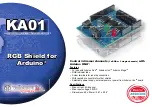
ENGINEERING MANUAL OF AUTOMATIC CONTROL
CONTROL FUNDAMENTALS
16
Fig. 19. Feedback in a Closed-Loop System.
In this example, the sensing element measures the discharge
air temperature and sends a feedback signal to the controller.
The controller compares the feedback signal to the setpoint.
Based on the difference, or deviation, the controller issues a
corrective signal to a valve, which regulates the flow of hot
water to meet the process demand. Changes in the controlled
variable thus reflect the demand. The sensing element continues
to measure changes in the discharge air temperature and feeds
the new condition back into the controller for continuous
comparison and correction.
Automatic control systems use feedback to reduce the
magnitude of the deviation and produce system stability as
described above. A secondary input, such as the input from an
outdoor air compensation sensor, can provide information
about disturbances that affect the controlled variable. Using
an input in addition to the controlled variable enables the
controller to anticipate the effect of the disturbance and
compensate for it, thus reducing the impact of disturbances on
the controlled variable.
CONTROL METHODS
GENERAL
An automatic control system is classified by the type of
energy transmission and the type of control signal (analog or
digital) it uses to perform its functions.
The most common forms of energy for automatic control
systems are electricity and compressed air. Systems may
comprise one or both forms of energy.
Systems that use electrical energy are electromechanical,
electronic, or microprocessor controlled. Pneumatic control
systems use varying air pressure from the sensor as input to a
controller, which in turn produces a pneumatic output signal
to a final control element. Pneumatic, electromechanical, and
electronic systems perform limited, predetermined control
functions and sequences. Microprocessor-based controllers use
digital control for a wide variety of control sequences.
Self-powered systems are a comparatively minor but still
important type of control. These systems use the power of the
measured variable to induce the necessary corrective action.
For example, temperature changes at a sensor cause pressure
or volume changes that are applied directly to the diaphragm
or bellows in the valve or damper actuator.
Many complete control systems use a combination of the
above categories. An example of a combined system is the
control system for an air handler that includes electric on/off
control of the fan and pneumatic control for the heating and
cooling coils.
Various control methods are described in the following
sections of this manual:
— Pneumatic Control Fundamentals.
— Electric Control Fundamentals.
— Electronic Control Fundamentals.
— Microprocessor-Based/DDC Fundamental.
See CHARACTERISTICS AND ATTRIBUTES OF
CONTROL METHODS.
ANALOG AND DIGITAL CONTROL
Traditionally, analog devices have performed HVAC control.
A typical analog HVAC controller is the pneumatic type which
receives and acts upon data continuously. In a pneumatic
controller, the sensor sends the controller a continuous
pneumatic signal, the pressure of which is proportional to the
value of the variable being measured. The controller compares
the air pressure sent by the sensor to the desired value of air
pressure as determined by the setpoint and sends out a control
signal based on the comparison.
The digital controller receives electronic signals from
sensors, converts the electronic signals to digital pulses
(values), and performs mathematical operations on these
values. The controller reconverts the output value to a signal
to operate an actuator. The controller samples digital data at
set time intervals, rather than reading it continually. The
sampling method is called discrete control signaling. If the
sampling interval for the digital controller is chosen properly,
discrete output changes provide even and uninterrupted control
performance.
Figure 20 compares analog and digital control signals. The
digital controller periodically updates the process as a function
of a set of measured control variables and a given set of control
algorithms. The controller works out the entire computation,
including the control algorithm, and sends a signal to an
actuator. In many of the larger commercial control systems,
an electronic-pneumatic transducer converts the electric output
to a variable pressure output for pneumatic actuation of the
final control element.
SETPOINT
FEEDBACK
CONTROLLER
SECONDARY
INPUT
CORRECTIVE
SIGNAL
FINAL CONTROL
ELEMENT
PROCESS
DISTURBANCES
CONTROLLED
VARIABLE
SENSING
ELEMENT
MANIPULATED
VARIABLE
C2072
Summary of Contents for AUTOMATIC CONTROL
Page 4: ...ENGINEERING MANUAL OF AUTOMATIC CONTROL iv ...
Page 6: ...ENGINEERING MANUAL OF AUTOMATIC CONTROL vi ...
Page 11: ...ENGINEERING MANUAL OF AUTOMATIC CONTROL CONTROL FUNDAMENTALS 1 CONTROL SYSTEMS FUNDMENTALS ...
Page 12: ......
Page 46: ...ENGINEERING MANUAL OF AUTOMATIC CONTROL CONTROL FUNDAMENTALS 36 ...
Page 66: ...PSYCHROMETRIC CHART FUNDAMENTALS 56 ENGINEERING MANUAL OF AUTOMATIC CONTROL ...
Page 128: ...ENGINEERING MANUAL OF AUTOMATION CONTROL ELECTRIC CONTROL FUNDAMENTALS 118 ...
Page 158: ...MICROPROCESSOR BASED DDC FUNDAMENTALS 148 ENGINEERING MANUAL OF AUTOMATIC CONTROL ...
Page 210: ...ENGINEERING MANUAL OF AUTOMATIC CONTROL BUILDING MANAGEMENT SYSTEM FUNDAMENTALS 200 ...
Page 440: ...ENGINEERING MANULA OF AUTOMATIC CONTROL INDIVIDUAL ROOM CONTROL APPLICATIONS 430 ...
Page 516: ...ENGINEERING MANUAL OF AUTOMATIC CONTROL GENERAL ENGINEERING DATA 506 Notes ...
Page 517: ...ENGINEERING MANUAL OF AUTOMATIC CONTROL GENERAL ENGINEERING DATA 507 Notes ...
Page 518: ...ENGINEERING MANUAL OF AUTOMATIC CONTROL GENERAL ENGINEERING DATA 508 ...
















































